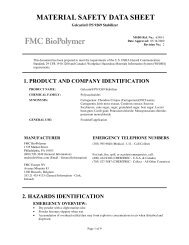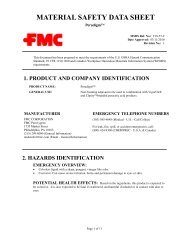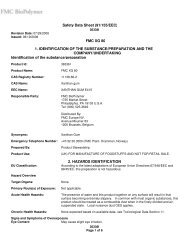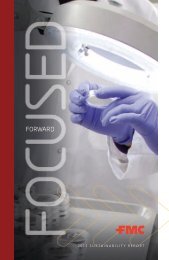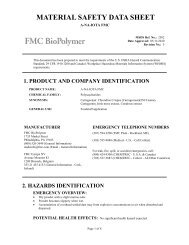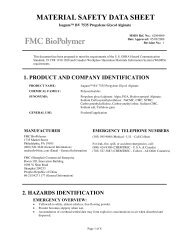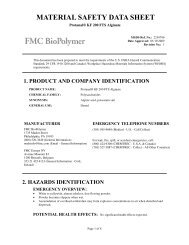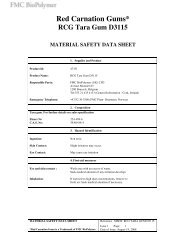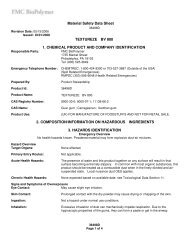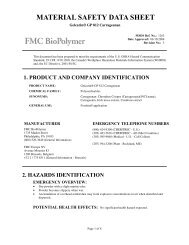FLONICAMID 50SG INSECTICIDE - FMC Corporation
FLONICAMID 50SG INSECTICIDE - FMC Corporation
FLONICAMID 50SG INSECTICIDE - FMC Corporation
Create successful ePaper yourself
Turn your PDF publications into a flip-book with our unique Google optimized e-Paper software.
BELEAF 50 SG <strong>INSECTICIDE</strong> (158062-67-0-2) Date: 12/30/2009<br />
FIRE FIGHTING PROCEDURES: Isolate fire area. Evacuate downwind. Wear full<br />
protective clothing and self-contained breathing apparatus. Do not breathe smoke, gases or vapors<br />
generated.<br />
6. ACCIDENTAL RELEASE MEASURES<br />
RELEASE NOTES: Isolate and post spill area. Wear protective clothing and personal protective<br />
equipment as prescribed in Section 8, "Exposure Controls/Personal Protection". Keep unprotected persons<br />
and animals out of the area.<br />
Keep material out of lakes, streams, ponds and sewer drains. Large spills should be covered to prevent<br />
dispersal. For dry material, use a wet sweeping compound or water to prevent the formation of dust. If<br />
water is used, prevent runoff or dispersion of excess liquid by diking and absorbing with a non-combustible<br />
absorbent such as clay, sand or soil. Vacuum, shovel or pump all waste material, including absorbent, into<br />
a drum and label contents for disposal.<br />
To clean and neutralize spill area, tools and equipment, wash with a suitable solution of strong soap and<br />
water. Absorb, as above, any excess liquid and add to the drums of waste already collected. Repeat if<br />
necessary. Dispose of drummed waste according to the method outlined in Section 13, "Disposal<br />
Considerations".<br />
7. HANDLING AND STORAGE<br />
HANDLING AND STORAGE: Store in a cool, dry, well-ventilated place. Do not use or<br />
store near heat, open flame or hot surfaces. Store in original containers only. Keep out of reach of children<br />
and animals. Do not contaminate other pesticides, fertilizers, water, food or feed by storage or disposal.<br />
8. EXPOSURE CONTROLS / PERSONAL PROTECTION<br />
PERSONAL PROTECTIVE EQUIPMENT<br />
EYES AND FACE: For dust exposure, wear chemical protective goggles or a face shield.<br />
RESPIRATORY: For dust exposures wear, as a minimum, a properly fitted half-face or<br />
full-face air-purifying respirator, which is approved for pesticides (U.S. NIOSH/MSHA, EU CEN<br />
or comparable certification organization). Respirator use and selection must be based on airborne<br />
concentrations.<br />
PROTECTIVE CLOTHING: Depending upon concentrations encountered, wear<br />
coveralls or long-sleeved uniform and head covering. For larger exposures as in the case of spills,<br />
wear full body cover barrier suit, such as a PVC suit. Leather items - such as shoes, belts and<br />
watchbands - that become contaminated should be removed and destroyed. Launder all work<br />
clothing before reuse (separately from household laundry).<br />
GLOVES: Wear chemical protective gloves made of materials such as rubber or nitrile.<br />
Thoroughly wash the outside of gloves with soap and water prior to removal. Inspect regularly for<br />
leaks.<br />
Page 3 of 8



